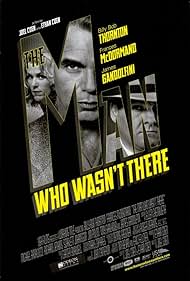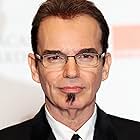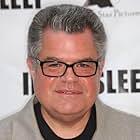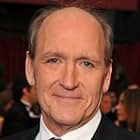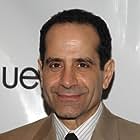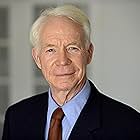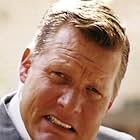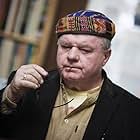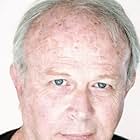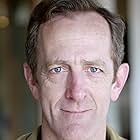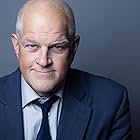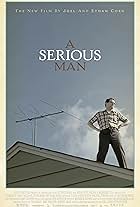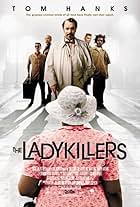Un barbiere laconico e fumatore incallito ricatta il capo (e amante) della moglie in cambio di denaro da investire in un lavaggio a secco, ma il suo piano va terribilmente storto.Un barbiere laconico e fumatore incallito ricatta il capo (e amante) della moglie in cambio di denaro da investire in un lavaggio a secco, ma il suo piano va terribilmente storto.Un barbiere laconico e fumatore incallito ricatta il capo (e amante) della moglie in cambio di denaro da investire in un lavaggio a secco, ma il suo piano va terribilmente storto.
- Candidato a 1 Oscar
- 25 vittorie e 43 candidature totali
Trama
Lo sapevi?
- QuizJoel Coen and Ethan Coen came up with the story while working on Mister Hula Hoop (1994). While filming the scene in the barbershop, the Coens saw a prop poster of 1940s haircuts and began developing a story about the barber who cut the hair in the poster.
- BlooperBirdy Abundas says that Ludwig van Beethoven "was deaf when he wrote this. [...] He never actually heard it", referring to his Piano Sonata No. 8 in C Minor, Op. 13, "Pathetique". When Beethoven composed this specific Sonata in 1798, he wasn't deaf. He already had some auditory troubles but he became totally deaf later, around 1815. During the very beginning of the 19th century he was still able to play public concerts and to hear the pieces he was composing.
- Citazioni
Reidenschneider: They got this guy, in Germany. Fritz Something-or-other. Or is it? Maybe it's Werner. Anyway, he's got this theory, you wanna test something, you know, scientifically - how the planets go round the sun, what sunspots are made of, why the water comes out of the tap - well, you gotta look at it. But sometimes you look at it, your looking changes it. Ya can't know the reality of what happened, or what would've happened if you hadn't-a stuck in your own goddamn schnozz. So there is no "what happened"? Not in any sense that we can grasp, with our puny minds. Because our minds... our minds get in the way. Looking at something changes it. They call it the "Uncertainty Principle". Sure, it sounds screwy, but even Einstein says the guy's on to something.
- Curiosità sui creditiThe opening titles cast shadows on the wall as if they are real.
- Versioni alternativeThough original intended to be released in black and white, the movie was originally shot in color. Some countries released the movie in color (e.g. Japan) for marketing reasons. Both versions are released on home media.
So far, so cool--and the movie is far easier to enjoy as a series of Abstracted Noir Components than the similarly suspension-of-disbelief-free LOST HIGHWAY. But then Noir Guy starts contemplating hair. He is the Sisyphus of Noirtown, performing a perfectly stupid task that never ceases to repeat itself, without gathering the slightest meaning. He even, in his blank way, waxes philosophical, like a Marine-town Woyzeck: "I want...I wanna put hair with...dirt, regular house dirt." "Ed, what the heck are ya talkin' about?" "I...Skip it."
And soon the movie metamorphs into a fedoras-and-Pall-Malls riff on Camus' THE STRANGER. Why does the Man Who Wasn't There kick off the chain of events that brings down all manner of ruination? Jealousy? Boredom? No ordinary human motives will do. And the Coens slyly insert a shyster lawyer (Tony Shalhoub) who's full of dime-store variants on post-structuralist touchstones: he uses the Heisenberg Uncertainty Principle as a sort of Twinkie Defense, and claims that his client is "Modern Man himself!...Indict him, and you are indicting yourself!" All of which, the Coens make clear, is so much malarkey--a way of kidding oneself, substituting entropy for dogma, avoiding the scary unknowableness of being alive.
Ethan Coen described THE MAN WHO WASN'T THERE as "the movie Martin Heidegger would have made if he had come to Hollywood"--unusually forthright for two guys who are just, aw shucks, entertainers. Like Spielberg's A.I., it uses a perfectedness of technique to render the world as an arrangement of totemic abstractions--pixilated dots that don't add up to a coherent object. The movie gets you, terrifyingly and melancholically, inside the head of a guy for whom the simplest, table-and-chairs stuff is ceasing to make sense. And the brothers use Carter Burwell's variant on Beethoven's "Moonlight Sonata" in a way that's as crazily persistent, and ceaselessly effective, as the insanely repetitive romantic theme from Godard's CONTEMPT. (Not even Godard has used late Beethoven so aptly.) Like BARRY LYNDON, another movie whose central question is "What kind of a man are you?," THE MAN WHO WASN'T THERE has an elusive, smokelike plangency. It's a picture you'll puzzle over, and sigh achingly at its images, for many years to come.
I più visti
- How long is The Man Who Wasn't There?Powered by Alexa
Dettagli
- Data di uscita
- Paesi di origine
- Lingue
- Celebre anche come
- The Man Who Wasn't There
- Luoghi delle riprese
- Aziende produttrici
- Vedi altri crediti dell’azienda su IMDbPro
Botteghino
- Budget
- 20.000.000 USD (previsto)
- Lordo Stati Uniti e Canada
- 7.504.257 USD
- Fine settimana di apertura Stati Uniti e Canada
- 664.404 USD
- 4 nov 2001
- Lordo in tutto il mondo
- 18.918.721 USD
- Tempo di esecuzione1 ora 56 minuti
- Colore
- Mix di suoni
- Proporzioni
- 1.85 : 1
Contribuisci a questa pagina

